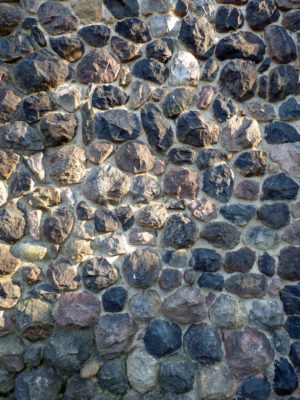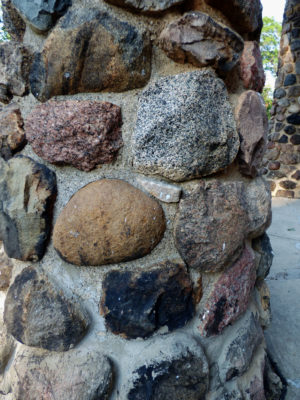Originally published July 2017
 One of the most distinctive exterior features of The Lamson House is the fact that the first floor is made entirely of field stone. Sydney Badgely, the house’s architect, was particularly fond of using stone in his designs. And if you ever wondered if the stone on The Lamson House is a façade or solid all the way through, I (and East Dominion employees who had to drill through it to install a new gas meter) can assure you that it is indeed two feet of solid stacked stone.
One of the most distinctive exterior features of The Lamson House is the fact that the first floor is made entirely of field stone. Sydney Badgely, the house’s architect, was particularly fond of using stone in his designs. And if you ever wondered if the stone on The Lamson House is a façade or solid all the way through, I (and East Dominion employees who had to drill through it to install a new gas meter) can assure you that it is indeed two feet of solid stacked stone.
Looking at the stone itself is fascinating. It becomes apparent very quickly that the stone did not come from one location. There are samples of different colored quartz, granite, sandstone and limestone. Plus others that I, without a geologist background, cannot identify. Some of the stones are rounded as though they came from a river or lake bed. While others are broken or cut, as though they came from some kind of building project. While others are rough and look like they were pulled out of a farmer’s field. Some are pristine and others are so badly soot damaged that no product or method that we have found yet will get them clean.
 Because of the wide variations in the stone used on the house, we often wonder “Where did the stone come from?” It is obvious that it was not simply something ordered from a local quarry. We have had several possibilities posed to us about where the stone came from. One person suggested that it may be ballast from ships. During that period in history when the house was built, ships would frequently use stones to make up weight when their hulls were empty and, since we are close to The Ohio Towpath which was still in operation at that time, this is a possibility. Others have suggested that the stone may have been reclaimed cobble stone pulled up from streets that were being repaved with bricks at the time.
Because of the wide variations in the stone used on the house, we often wonder “Where did the stone come from?” It is obvious that it was not simply something ordered from a local quarry. We have had several possibilities posed to us about where the stone came from. One person suggested that it may be ballast from ships. During that period in history when the house was built, ships would frequently use stones to make up weight when their hulls were empty and, since we are close to The Ohio Towpath which was still in operation at that time, this is a possibility. Others have suggested that the stone may have been reclaimed cobble stone pulled up from streets that were being repaved with bricks at the time.
Regardless of where the stone came from, there is no denying that the fact that the stone first floor makes for an impressive and unique structure. It is yet one more feature of the house that would be difficult, if not impossible, to try to do in a modern home. Bedford has many historic homes that have features like this and we Bedfordites are privileged to have so many examples of them in our city.